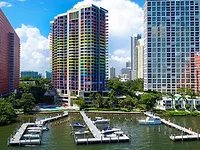Polyaspartic Binders for the Largest Media Façade in the World
The
innovative topcoat Intercure® 99 from International Paint, part of
AkzoNobel, will give the 30,000-square-meter surface of this steel structure
long-term protection from corrosion.

The 122-meter-high former Bayer headquarters in Leverkusen is currently being converted into one of the world’s largest media facades. From mid-2009 onwards, a colored Bayer Cross, up to 40 meters in diameter, will be visible day and night, sending messages out about Bayer across the Leverkusen region, some of them set in motion. Alongside this spectacular light show, Bayer will set standards in other respects too; the innovative topcoat Intercure® 99 from International Paint, part of AkzoNobel, will give the 30,000-square-meter surface of the steel structure long-term protection from corrosion. Based on polyaspartic binding agents from Bayer MaterialScience’s Desmophen® NH range, the product offers enormous economic and ecological benefits over conventional coating systems.

The lower number of coats required also eliminates a work step, thus reducing labor costs. In addition, the application and drying of two layers comprising primer and topcoat at room temperature (25 °C) only takes 6 to 8 hours, of which merely 1.5 hours is taken up with the drying of Intercure 99. A coatings applicator rehabilitating buildings can therefore begin working on adjacent surfaces much sooner – a further plus in economic terms. For comparison, a conventional three-layer system takes 24 hours to apply and dry. It is also possible to replace traditional two-layer systems comprising primer and topcoat with a one-layer “direct-to-metal” application of Intercure 99.

Excellent productivity and good environmental compatibility are decisive factors for enabling coating systems to achieve success in the market for applications such as wind farms, silos and cranes. However, as a polyaspartic system, Intercure 99 possesses a further characteristic that makes it exceptionally attractive not just for the Bayer media facade but also for other representative buildings such as stadiums, bank headquarters, museums and airports: its high colorfastness and gloss retention. This property ensures a highly esthetically pleasing appearance that can withstand the ravages of time for many years.
“The experts at AkzoNobel International Paint recognized the potential of our polyaspartic binding agents at a very early stage,” says Bäker. AkzoNobel and Bayer worked closely together during preparations to bring the corresponding systems to market.
More information can be found at www.bayermaterialscience.com and www.international-pc.com.

The 122-meter-high former Bayer headquarters in Leverkusen is currently being converted into one of the world’s largest media facades. From mid-2009 onwards, a colored Bayer Cross, up to 40 meters in diameter, will be visible day and night, sending messages out about Bayer across the Leverkusen region, some of them set in motion. Alongside this spectacular light show, Bayer will set standards in other respects too; the innovative topcoat Intercure® 99 from International Paint, part of AkzoNobel, will give the 30,000-square-meter surface of the steel structure long-term protection from corrosion. Based on polyaspartic binding agents from Bayer MaterialScience’s Desmophen® NH range, the product offers enormous economic and ecological benefits over conventional coating systems.

Economic Benefits
In the past, whenever steel structures such as bridges or power stations needed to be protected against the effects of wind and weather, it was usually necessary to apply three layers of coating. “Intercure 99 on the other hand makes it possible to increase productivity and only requires two layers,” says Terence M. Gilhooley, Sales Manager Central Europe AkzoNobel International Paint. One of the reasons why the third layer is no longer needed is explained by Thomas Bäker, manager of the BMS corrosion protection laboratory: “With coatings based on polyaspartics, a significantly thicker layer can be applied in a single application than with conventional topcoats.”The lower number of coats required also eliminates a work step, thus reducing labor costs. In addition, the application and drying of two layers comprising primer and topcoat at room temperature (25 °C) only takes 6 to 8 hours, of which merely 1.5 hours is taken up with the drying of Intercure 99. A coatings applicator rehabilitating buildings can therefore begin working on adjacent surfaces much sooner – a further plus in economic terms. For comparison, a conventional three-layer system takes 24 hours to apply and dry. It is also possible to replace traditional two-layer systems comprising primer and topcoat with a one-layer “direct-to-metal” application of Intercure 99.

Ecological Benefits
The environment also benefits from the absence of additional coating layers. “The VOC content of a two-layer system with an Intercure 99 topcoat is about 40 percent lower than with a comparable three-layer system,” says Gilhooley. Coatings based on polyaspartics thus help solve the problem of increasingly strict VOC guidelines. “Combined with a low-viscosity polyurethane curing agent from the Desmodur® N range, polyaspartics allow the formulation of ultra-high-solid coatings with a low VOC content that more than meet the current statutory requirements,” says BMS expert Bäker.Excellent productivity and good environmental compatibility are decisive factors for enabling coating systems to achieve success in the market for applications such as wind farms, silos and cranes. However, as a polyaspartic system, Intercure 99 possesses a further characteristic that makes it exceptionally attractive not just for the Bayer media facade but also for other representative buildings such as stadiums, bank headquarters, museums and airports: its high colorfastness and gloss retention. This property ensures a highly esthetically pleasing appearance that can withstand the ravages of time for many years.
“The experts at AkzoNobel International Paint recognized the potential of our polyaspartic binding agents at a very early stage,” says Bäker. AkzoNobel and Bayer worked closely together during preparations to bring the corresponding systems to market.
More information can be found at www.bayermaterialscience.com and www.international-pc.com.
Looking for a reprint of this article?
From high-res PDFs to custom plaques, order your copy today!






